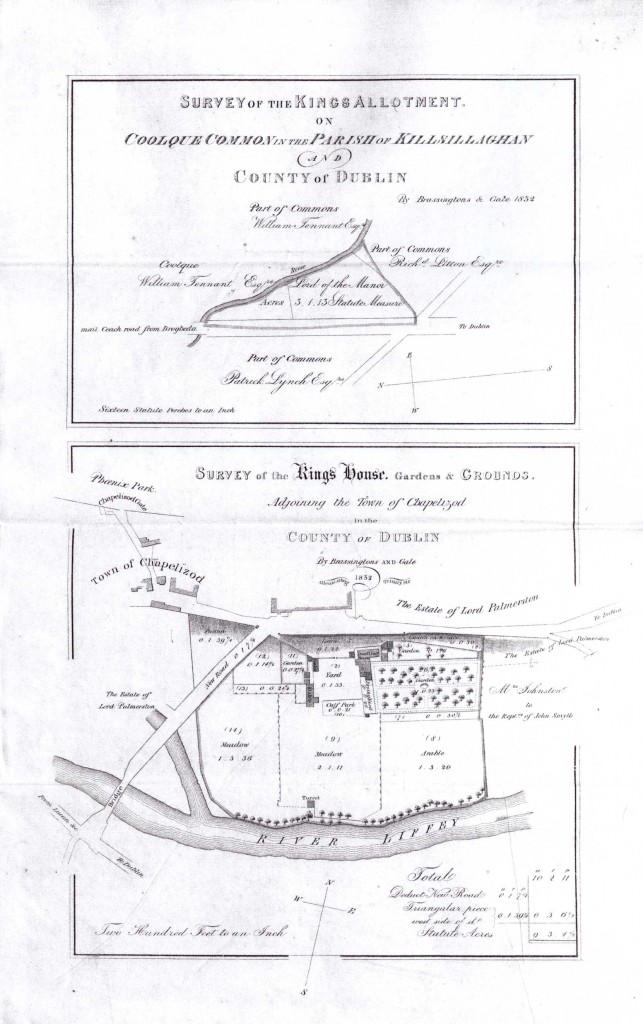Quit Rent Office
Published in 18th-19th Century Social Perspectives, 20th Century Social Perspectives, Features, Issue 1 (January/February 2015), Volume 23
‘Survey of the King’s Allotment. On Coolque Common in the Parish of Killsillaghan and County of Dublin’, Quit Rent Office. (NAI)
The Quit Rent Office holds records relating to some of the Crown’s former land revenues, natural assets and franchises in Ireland between the 1660s and the 1930s. In 1923 the records were transferred to the Irish Free State. After 1943 the historic Quit Rent Office records were transferred to the Public Records Office (now the National Archives), and its function was taken over by the Land Commission.
The Crown held urban and agricultural estates in all Irish counties, and quite detailed estate records survive, including leases, rentals and tenant lists. The starting dates of records for distinct estates are not uniform: for example, Crown rentals in towns including Sligo, Galway and Limerick survive from the 1680s, whereas tenant lists for Kingwilliamstown in Cork (formerly Pobal O’Keefe, afterwards Ballydesmond) only start in the 1730s. As a rule of thumb, tenant lists for agricultural estates don’t go below the yeomanry (strong farmers). Urban estates provide much greater social coverage, however, as they include the names of principal tenants by tenement.
During the Famine over 1,100 tenants on Crown estates availed of assisted emigration schemes to re-settle in North America. In some instances more than 95% of all tenants emigrated from Crown estates in Cork, Galway, Kerry, Offaly and Roscommon.
The Crown’s revenues in Ireland were multifarious and, in addition to land revenues, it was entitled to a range of royalties and franchises deriving from fairs and markets, fisheries and ferries, rights of foreshore (including inland lakes, harbours and piers) and mining rights. The Quit Rent Office collection contains what are essentially management records for these valuable assets, including receipts, leases, patents and letter-books from between c. the 1660s and the 1930s.
Probably the most significant part are the land surveys carried out between 1636 and 1658 to determine the extent, use and ownership of land in Ireland. These surveys were the basis for the Cromwellian confiscations. Between 1653 and 1688, 2,500,000 Irish plantation acres were seized and redistributed as collateral for Parliament’s debts incurred in the English Civil War. The English Commonwealth wanted to abolish feudal tenure, and all Irish lands assigned were to be held by a ‘quit rent’—a simple cash payment charged by the acre, in perpetuity. Ironically, and somewhat inevitably, at the time of the Restoration these quit rents were reserved to the Crown.
The Quit Rent Office manuscript collection includes a partial set of the Civil Survey of 1654–6, including all barony volumes for ten counties, part of Cork city and county, and the barony of Clanmorris, Co. Kerry; a partial set of 1655–8 Down Survey maps for 89 baronies; and twenty volumes of the Books of Survey and Distribution, encompassing 29 counties, created c. 1682 and derived from the records of the Civil Survey and Down Survey, but which also incorporate Stafford’s earlier (1636–7) surveys of counties Galway, Mayo, Roscommon, Sligo and Clare, and the 1653 Gross Survey of the barony of Farney, Co. Monaghan.
The Quit Rent Office copies of the Books of Survey and Distribution also include revisions to landholding made during the Commission of Grace, 1684–8, and in 1703/4 on the sale of estates forfeited in 1688. These surveys provide a detailed record of changes in land use and ownership in Ireland between the 1630s/40s and 1703/4. They are a key source for tracing families dispossessed by conquest, some of whom relocated within Ireland but many of whom settled overseas in Europe or the Americas.
Fiona Fitzsimons is a director of Eneclann, a Trinity College campus company, and of findmypast Ireland.
















